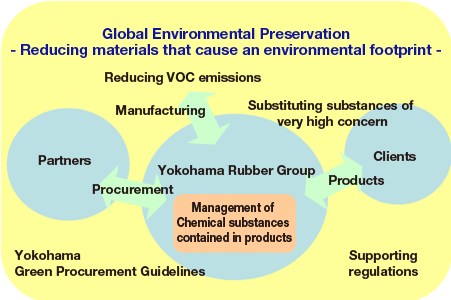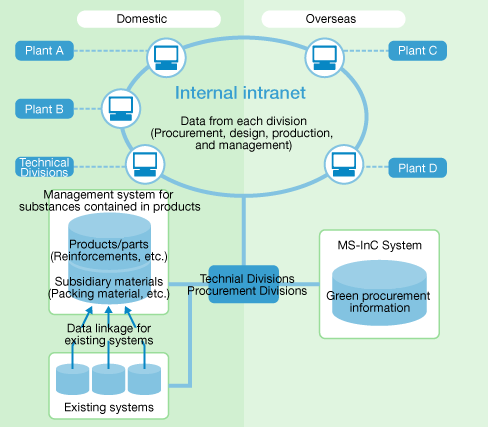Environmental Preservation
Management of Chemicals
Guidelines and Supporting Systems for the Management of Chemicals
Although up until now it has enough to manage specific toxic substances, such as those designated by the EU’s (ELV *1) Directive, the number of toxic substances subject to management (such as substances of concern (SOC *2) and substances of very high concern (SVHC *3) are increasing every year. Currently, in order to comply with chemical materials management laws and regulations in Japan and overseas and promote environmental preservation, it is necessary to manage chemical substances contained in products throughout the entire supply chain. We manage chemical substances contained in products on a global scale and provide products that do not contain substances such as substances of very high concern.
- *1.
- ELV: An EU directive aimed at reducing the environmental load of scrapped vehicles (restricts use of lead, mercury, cadmium, and hexavalent chromium)
- *2.
- SOC: In addition to 6 substances which are prescribed by RoHS, restricts use of deca-PBD, hexabromocyclododecane, perfluorooctane sulfonate (PFOS), asbestos, and other substances (a total of 10 substances)
- *3.
- SVHC: Designates substances subject to authorization and registration based on the REACH Regulation, candidate substance are added as necessary

Establishment of a Global Product Chemical Substance Management System
We have used the internal integrated management system, MS-InC, which is a company-wide common management method for information on chemical substances contained in purchased goods (raw materials, subsidiary materials, and parts) and can manage specific toxic substances and to guarantee the non-inclusion of substances of concern (SOC). Furthermore, we started operation of an advanced management system for chemical substances contained in products that links product information and constituent materials information from FY 2014 in order to ensure the global management of chemical substances contained in products in accordance with the European REACH regulations and other regulations. Using these systems we manage the substances contained in the purchased products that are used by our domestic and overseas business locations, and we are able to identify materials, parts, and products that contain specific chemical substances in real time Through these initiatives we aim to strengthen our chemical substance management system across all divisions.
Furthermore, in order to understand and improve the level of chemical substance management, we have established chemical substance management standards. Self-assessment checks on chemical substances are conducted at domestic and overseas business locations and efforts are made to assess issues involving chemical substance management and make improvements. Through these efforts we are building a framework that allows us to maintain and improve the level of chemical substance management at domestic and overseas factories.
Chemical Substance Management System Concept Diagram

Measurement for Legal Regulations
As part of our global support, we have completed regulation in accordance with the EU’s REACH Regulation within the export quantity limitations and the registration deadline for products that are imported directly or indirectly to the EU. Furthermore, we have completed notification under the CLP Regulation for chemical products such as adhesives, and to support the GHS *1 that has been adopted by countries around the world we are issuing SDS *2 and applying product labels. In response to domestic regulations and in compliance with the revised Chemical Substance Control Law, this year we have continued to submit notification on the quantity and use of raw materials purchased overseas.
In accordance with the Dodd-Frank Act issued by America’s Securities and Exchange Surveillance Commission (SEC), minerals (tantalum, tin, gold, and tungsten) from conflict areas in the Congo are defined as conflict minerals, and listed companies are required to disclose information on their use. We do not intentionally use conflict minerals extracted from the Congo and the surrounding countries and investigations have confirmed that we do not use conflict minerals extracted from these regions.
See our procurement policy here.
- *1.
- GHS: The Globally Harmonized System of Classification and Labeling of Chemicals as stipulated by the United Nations that specifies the basic format for label display and SDS preparation
- *2.
- SDS: Safety data sheet for chemical substances required for the communication of safety information
Promoting of the Reduction of Substances of Environmental Concern
In response to changes in the chemical substance regulations of various nations such as the EU’s ELV Directive and the RoHS Directive *1, as well as the REACH Regulation *2 and CLP Regulation *3, we conduct technological development for alternatives to substance subject to regulation and develop construction methods to reduce VOC emissions.
- Case of development of a urethane coating waterproofing material that does not contain specified chemical substances (waterproofing material for construction)
Urban Roof/U-8000 SF was developed as a two-component urethane coating waterproofing material for waterproofing buildings and apartments. While tolylene diisocyanate (TDI) and 3-3 indolyl 4-4 diaminodiphenyl methane (MOCA) that are chemicals specified by the Ministry of Health, Labour, and Welfare are generally used for waterproofing materials, we succeeded in the development of a material that has a Free-TDI content of less than 1% and does not require MOCA. As a result, the work load for workers has been reduced as they are no longer required to wear protective equipment, and contributions have been made to the durability and weight reduction of buildings through an increase in the polymer ratio and a decrease in density. No longer obligatory to wear protective equipment
No longer obligatory to wear protective equipment - Case of initiatives to reduce VOC emissions (building sealant)
Hamatite/UH-01NB was developed as an environmentally friendly sealant for filling the joints of facilities such as general housing and schools. The product does not contain organic solvent (*4BTX) and lead compounds and has a Free-TDI content of less than 1%. The product has been favorably received as it secures both working time and the aesthetics of buildings. Construction status
Construction status
- *1.
- RoHS: An EU regulation on hazardous substances used in electrical and electronic equipment (restricts use of lead, mercury, cadmium, hexavalent chromium, polybrominated biphenyl (PBB), and polybrominated diphenyl ether (PBDE))
- *2.
- REACH: Authorization system for chemical substances supervised under the EU’s ECHA
- *3.
- CLP: A regulation on the classification, labeling, and packaging of substances announced by the EU and their compounds and molded articles
- *4.
- BTX: General term for the aromatic solvents benzene, toluene, and xylene